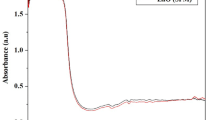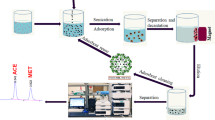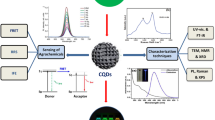Abstract
A fast and efficient fluorescent probe based on carbon quantum dots (CQDs) was studied to detect ferric ions (Fe3+) in tap water. Cow milk-derived carbon quantum dots (CMCQDs) were synthesized via hydrothermal method using milk as the carbon source. The size, morphology, surface composition, optical properties and stability of the CMCQDs were fully characterized. The obtained CMCQDs show blue fluorescence, uniform distribution, small particle size and excellent fluorescence stability. There is a specifically quenching effect on CMCQDs by Fe3+, so the CMCQDs can be employed as a fluorescence probe for determination of Fe3+ with high selectivity and sensitivity. The limit of detection (LOD) is 0.6 μmol/L in the range of 0.1–20 μmol/L (R2 = 0.9911). Herein, the fluorescent quenching of CMCQDs is thought to result from the by the unique chelation or coordination between Fe3+ and surface functional groups of CMCQDs. The sensitive and selective fluorescent probe was confirmed to demonstrate high potential in Fe3+ detection in tap water.
Graphical Abstract

Cow milk-derived carbon quantum dots (CMCQDs) were synthesized via hydrothermal method using milk as the carbon source. There is a specifically quenching effect on CMCQDs by Fe3+, so the CMCQDs can be employed as a fluorescence probe for determination of Fe3+ with high selectivity and sensitivity.
Highlights
-
Cow milk-derived carbon quantum dots (CMCQDs) were synthesized for sensitive and selective detecting Fe3+ in tap water.
-
The sensing mechanism of the detection is result from the unique chelation or coordination between Fe3+ and surface functional groups of CMCQDs.
-
The limit of detection (LOD) is 0.6 μmol/L in the range of 0.1-20 μmol/L.















Similar content being viewed by others
References
Wang GQ, Liu XW, Cai SK, Zhang SR, Cui JZ, Gao CZ, Cheng ZF (2021) A pyrene fluorescent probe for rapid detection of ferric ions. J fluorescence 31:713–718
Nayab PS, Shkir M (2017) Rapid and simultaneous detection of Cr (III) and Fe (III) ions by a new naked eye and fluorescent probe and its application in real samples. Sens Actuators: B Chem 251:951–957
Narayanaswamy N, Govindaraju T (2012) Aldazine-based colorimetric sensors for Cu2+ and Fe3+. Sensors & actuators: B. chemical 161:304–310
Weerasinghe AJ, Schmiesing C, Varaganti S, Ramakrishna G, Sinn E (2010) Single- and multiphoton turn-on fluorescent Fe3+ sensors based on bis(rhodamine). J Phys Chem B 114:9413–9419
Yang Z, She MY, Yin B, Cuo JH, Zhang YZ, Sun W, Li JL, Shi Z (2012) Three Rhodamine-based “off-on” chemosensors with high selectivity and sensitivity for Fe3+ imaging in living cells. J Org Chem 77:1143–1147
Wang R, Yu FB, Liu P, Chen LX (2012) A turn-on fluorescent probe based on hydroxylamine oxidation for detecting ferric ion selectively in living cells. Chem Commun 48:5310–5312
China. Hygienic standard for drinking water (GB5749-2006). 2006.
Liu FJ, Jiang Y, Fan C, Zhang LY, Hua Y, Zhang CX, Song N, Kong YJ, Wang H (2018) Fluorimetric and colorimetric analysis of total iron ions in blood or tap water using nitrogen-doped carbon dots with tunable fluorescence. N. J Chem 42:9676–9683
Yu Y, Zhao Q, Bao HL, Mou Q, Shi ZM, Chen YL, Gao Y (2020) Determination of trace bismuth in environmental waters by ICP-MS with cobalt ion-assisted photochemical vapour generation. N. Sci 44:617–627
Ghaedi M, Niknam K, Niknam E, Soylak M (2009) Application of cloud point extraction for copper, nickel, zinc and iron ions in environmental samples. J Chin Chem Soc 56:981–986
Abbaspour A, Kamyabi MA, Khalafi-Nezhad A, Rad MNS (2004) Charge-transfer complexometric study of ferric ion with 4-chloro-2,6-bis (hydroxymethyl) phenol in a Methanol−Water System Using Spectrophotometric and Potentiometric Methods. J Chem Eng data 49:907–911
Oreshkina NS, Cavaletto SM, Keitel CH, Harman Z (2016) X-ray fluorescence spectrum of highly charged Fe ions driven by strong free-electron-laser fields. J Phys B: At, Mol optical Phys 49:094003
Mintz KJ, Zhou YQ, Leblanc RM (2019) Recent development of carbon quantum dots regarding their optical properties, photoluminescence mechanism, and core structure. Nanoscale 11:4634–4652
Namdari P, Negahdari B, Eatemadi A (2017) Synthesis, properties and biomedical applications of carbon-based quantum dots: An updated review. Biomedicine Pharmacother 87:209–222
Kalalyarasan G, Joseph J, Kumar P (2020) Phosphorusdoped carbon quantum dots as fluorometric probes for iron detection. ACS omega 5:22278–22288
Wang CJ, Shi HX, Yang M, Yan YJ, Liu EZ, Ji Z, Fan J (2020) Facile synthesis of novel carbon quantum dots from biomass waste for highly sensitive detection of iron ions. Mater Res Bull 124:110730
Landa SDT, Bogireddy NKR, Kaur I, Batra V, Agarwal V (2022) Heavy metal ion detection using green precursor derived carbon dots. Science 25:103816
Jing SS, Zhao YS, Sun RC, Zhong LX, Peng XW (2019) Facile and High-Yield Synthesis of carbon quantum dots from biomass-derived carbons at mild condition. ACS Sustain chem eng 7:7833–7843
Chang KX, Zhu QJ, Qi LY, Guo MW, Gao WM, Gao QW (2022) Synthesis and properties of nitrogen-doped carbon quantum dots using lactic acid as carbon source. Materials 15:466–479
Wang L, Zhou HS (2014) Green Ssynthesis of luminescent nitrogen-doped carbon dots from milk and its imaging application. Anal Chem 86:8902–8905
Liu W, Diao H, Chang H, Wang H, Li T, Wei W (2017) Green synthesis of carbon dots from rose-heart radish and application for Fe3+ detection and cell imaging. Sens actuators B chem 241:190–198
Jia MY, Peng LL, Yang MH, Wei HZ, Zhang M, Wang YU (2021) Carbon dots with dual emission: a versatile sensing platform for rapid assay of Cr (VI). Carbon 182:42–50
Ai L, Yang YS, Wang BY, Chang JB, Tang ZY, Yang B, Lu SY (2021) Insights into photoluminescence mechanisms of carbon dots: advances and perspectives. Sci Bull 66:839–856
Wang H, Sun C, Chen XR, Zhang Y, Colvin VL, Rice Q, Seo J, Feng SY, Wang SN, Yu WW (2017) Excitation wavelength independent visible color emission of carbon dots. Nanoscale 9:1909–1915
Lv XM, Man HS, Dong LJ, Huang JY, Wang XY (2020) Preparation of highly crystalline nitrogen-doped carbon dots and their application in sequential fluorescent detection of Fe3+ and ascorbic acid. Food Chem 326:126935
Han S, Zhang H, Xie YJ, Liu LL, Shan C, Li XK, Liu WS, Tang Y (2015) Application of cow milk-derived carbon dots/Ag NPs composite as the antibacterial agent. Appl Surf Sci 328:368–373
Fan R, Xiang JX, Zhou PP, Mei H, Li YY, Wang HL, Liu XD, Wang XD (2022) Reuse of waste Myrica rubra for green synthesis of nitrogen-doped carbon dots as an “on-off-on” fluorescent probe for Fe3+ and ascorbic acid detection. Ecotoxicol Environ Saf 233:113350
Long P, Feng YY, Cao C, Li Y, Han JK, Li SW, Peng C, Li ZY, Feng W (2018) Self-protective room-temperature phosphorescence of fluorine and nitrogen codoped carbon dots. Adv Funct Mater 28:1800791
Cui X, Wang Y, Liu J, Yang Q, Zhang B, Gao Y, Wang Y, Lu G (2017) Dual functional N- and S-co-doped carbon dots as the sensor for temperature and Fe3+ ions. Sens actuators B chem 242:1272–1280
Zhou J, Yang Y, Zhang CY (2013) A low-temperature solid-phase method to synthesize highly fluorescent carbon nitride dots with tunable emission. Chem 49:8605–8607
Liu XH, Li HB, Shi LJ, Meng XR, Wang YJ, Chen X, Xu H, Zhang WK, Fang XM, Dinga T (2017) Structure and photoluminescence evolution of nanodots during pyrolysis of citric acid: from molecular nanoclusters to carbogenic nanoparticles. J Mater Chem C 5:10302–10312
Yu CY, Xuan TT, Chen YW, Zhao ZJ, Sun Z, Li HL (2015) A facile, green synthesis of highly fluorescent carbon nanoparticles from oatmeal for cell imaging. J Mater Chem C 3:9514–9518
Gao WL, Song HH, Wang X, Liu X, Pang XB, Zhou Y, Gao B, Peng XJ (2018) Carbon dots with red emission for sensing of Pt2+, Au3+, and Pd2+ and their bioapplications in vitro and in vivo. ACS Appl Mater Interfaces 10:1147–1154
Zhang HJ, Chen YL, Liang MJ, Xu LF, Qi SD, Chen HL, Chen XG (2014) Solid-phase synthesis of highly fluorescent nitrogen-doped carbon dots for sensitive and selective probing ferric ions in living cells. Anal Chem 86:9846–9852
Yang F, Bao WJ, Liu TX, Zhang B, Huang S, Yang W, Li Y, Li N, Wang CX, Pan CW, Li YF (2020) Nitrogen-doped graphene quantum dots prepared by electrolysis of nitrogen-doped nanomesh graphene for the fluorometric determination of ferric ions. Inorg Chem Commun 187:322
Omer KM, Tofiq D, Hassan AQ (2018) Solvothermal synthesis of phosphorus and nitrogen doped carbon quantum dots as a fluorescent probe for iron(III). Mikrochimica acta 185:466
Zhu SJ, Song YB, Zhao XH, Shao JR, Zhang JH, Yang B (2015) The photoluminescence mechanism in carbon dots (graphene quantum dots, carbon nanodots and polymer dots): current state and future perspective. Nano Res 8:355–381
Zhu S, Meng Q, Wang L, Zhang J, Song Y, Jin H, Zhang K, Sun H, Wang H, Yang B (2013) Highly photoluminescent carbon dots for multicolor patterning, sensors, and bioimaging. Angew Chem Int Ed 125:4045–4049
Cai Y, Zhang J, Zhang M, Wang MH, Zhao Y (2022) The optical fiber sensing platform for ferric ions detection: A practical application for carbon quantum dots. Sens Actuators: B Chem 364:131857
Acknowledgements
This work is financially supported by Science and Technology Project of Chongqing Education Commission (KJQN201900504) and (KJQN201800505).
Author information
Authors and Affiliations
Corresponding author
Ethics declarations
Conflict of interest
The authors declare no competing interests.
Additional information
Publisher’s note Springer Nature remains neutral with regard to jurisdictional claims in published maps and institutional affiliations.
Rights and permissions
Springer Nature or its licensor (e.g. a society or other partner) holds exclusive rights to this article under a publishing agreement with the author(s) or other rightsholder(s); author self-archiving of the accepted manuscript version of this article is solely governed by the terms of such publishing agreement and applicable law.
About this article
Cite this article
Zhang, L., Li, B., Zhou, Y. et al. Green synthesis of cow milk-derived carbon quantum dots and application for Fe3+ detection. J Sol-Gel Sci Technol 106, 173–185 (2023). https://doi.org/10.1007/s10971-022-06024-3
Received:
Accepted:
Published:
Issue Date:
DOI: https://doi.org/10.1007/s10971-022-06024-3




